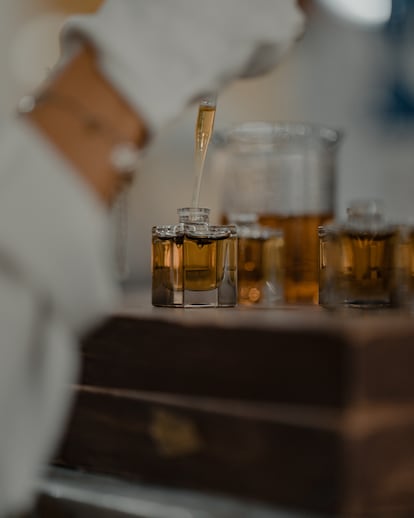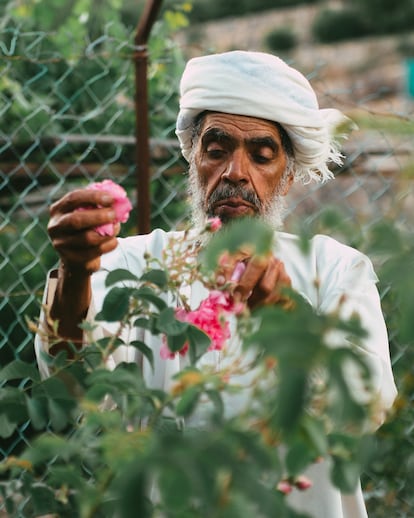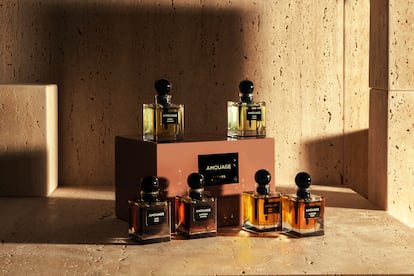The return of the oldest, most luxurious perfume in the world
Amouage recovers the attar tradition, an oil-based fragrance from India with mythical status

Two years ago, the perfumer Cécile Zarokian received an unusual request. It came from Renaud Salmon, the creative director of Amouage, a luxury perfume house founded in Oman: he was to assume a challenge the perfume house had pending, namely, to reinvent a portion of its collection of attars – oil-based perfumes that previously only people living in Oman were legally able to buy.
To meet the challenge, the perfumer had to undertake the kind of meticulous market research that can’t be done online: “Creating a 100% pure oil fragrance was completely new to me, and a huge challenge,” says Zarokian. “I visited a lot of souks, contacted traditional suppliers to receive samples and discussed the matter at length. All the fragrances had that particular raw, wild dimension, with a certain roughness and a lot of texture, depth and richness. That’s what I needed to work with to develop my formulas. Without it, I would have lost the soul of the genuine attar.”
There’s nothing arbitrary about the process of concocting an attar. A faithful testament to the evolution of perfume making, the attar – or Ittar – boasts more than 60,000 years of history and an ancestral tradition of secret formulas that were passed down from generation to generation.
An attar depends on who makes it. From the legendary rose compositions, such as the classic Gulab, to the current versions with the most expensive ouds, each concoction is infused with a unique mystery. Furthermore, the attar cannot be separated from ancient ritual and therapeutic uses. Hindu sadhus and spiritual seekers used these scents for their journey to enlightenment. They were also used by the Sufi dervishes for their hypnotic dances.

The first attars were concocted by doctors and used for medicinal purposes, according to the quality of their ingredients: applied cold, attars made from jasmine and rose were used to bring down fevers or to cool off in hot temperatures. Warm attars made from saffron or oud were used to increase body temperature. The purpose of this oldest perfume in the world was primarily to cure and to use as an offering to the gods. Made from grinding the natural botanical ingredients in pure oil, often sandalwood, it would be left to mature until it obtained an intensity quite different from modern perfumes which use alcohol or a solvent as a base, which is, of course, more economical and widely available. The ageing process for attars can range from one to 10 years.
The complexity of the process means that the attar reacts differently on different skins. The warmth of our skin releases an aroma of sweet, smoked or spicy nuances. The attar can be simple, such as the Gulab, made from rose petals steeped in sandalwood, or more complex, such as the Shamama attar, with has more than 40 ingredients, including flowers, herbs and resins. One of the most popular is the Mitti attar – perfume of the earth – which is a blend of botanical plants that evokes the exact moment when the monsoon hits the dry earth. This later became known as Petricor – the fragrance of rain, although there are now many different versions.
The first attars were made in India, or more specifically, Kannauj in Uttar Pradesh, the epicenter of the perfume culture. References to its elaboration can be found in 6th century texts, and legend has it that the governor of the city of Awadh would put attar around his bedroom for aphrodisiacal purposes. The most exclusive perfumes, bottled in small decanters, were given to guests as a gesture of hospitality, a custom specific to the Mughal Empire. Being largely concocted from base notes, the fragrance was very rich and intense. The superior quality of the ingredients and the complex process they underwent to produce the attar meant the result was something akin to liquid gold with an equivalent price tag. The attar was, in fact, a treasure which became all but extinct due to the difficulty in acquiring the traditional ingredients, such as the coveted sandalwood or the wild oud.

In fact, Amouage is one of the few international perfume houses that has kept the attar tradition alive. Last year, the firm, founded by Omani royalty in the 1980s, presented its new collection of concentrated perfume oils to replace the one that preceded it – a collection discontinued some years back. Cécile Zarokian has been put in charge of replicating some of the most emblematic attars for the Amouage house, such as Rose Aqor (inspired by the ancient rose-based Ruh Gulab) and Saffron Hamra (using the world’s most expensive spice, Kesar).
The attar is also very complex from a technical point of view, as today’s attars must comply with strict international perfume regulations. “I wanted to pay a contemporary but legitimate tribute to this ancient tradition to honor the heritage and allow the people to remember the origins of perfume,” says Zarokian. The Saffron Hamra attar, combining saffron, rose and Cade wood, is an ode to the red hue of the Al Hamra village at the foot of Oman’s highest peak. It is an opulent scent, but also balsamic due to the medicinal properties of the coveted Kesar spice.
So, is this the reincarnation of the attar? The growing popularity of oil-based perfumery is almost certainly due to the naturalness of its ingredients and the craftsmanship involved in putting it together. “Attars meet the demands of current trends,” says Zarokian. “The intimate gesture of applying a few drops is in line with our focus on self-care and wellbeing, so much in vogue in recent years. The traditional and historical aspect addresses the thirst for authenticity and knowledge, and the natural and alcohol-free ingredients address the trend of clean, nature-oriented beauty.”
Sign up for our weekly newsletter to get more English-language news coverage from EL PAÍS USA Edition
Tu suscripción se está usando en otro dispositivo
¿Quieres añadir otro usuario a tu suscripción?
Si continúas leyendo en este dispositivo, no se podrá leer en el otro.
FlechaTu suscripción se está usando en otro dispositivo y solo puedes acceder a EL PAÍS desde un dispositivo a la vez.
Si quieres compartir tu cuenta, cambia tu suscripción a la modalidad Premium, así podrás añadir otro usuario. Cada uno accederá con su propia cuenta de email, lo que os permitirá personalizar vuestra experiencia en EL PAÍS.
¿Tienes una suscripción de empresa? Accede aquí para contratar más cuentas.
En el caso de no saber quién está usando tu cuenta, te recomendamos cambiar tu contraseña aquí.
Si decides continuar compartiendo tu cuenta, este mensaje se mostrará en tu dispositivo y en el de la otra persona que está usando tu cuenta de forma indefinida, afectando a tu experiencia de lectura. Puedes consultar aquí los términos y condiciones de la suscripción digital.
More information
Últimas noticias
Maduro pleads not guilty before the federal court in New York: ‘I am still the president of Venezuela’
A new test can detect Alzheimer’s from a finger prick
UN team enters Sudanese city of El Fasher after paramilitary massacre: ‘It’s like a ghost town’
A recipe for resistance: Indigenous peoples politicize their struggles from the kitchen
Most viewed
- Gilles Lipovetsky: ‘If you want to live better and fall in love, take Prozac, don’t look to philosophy’
- Alain Aspect, Nobel laureate in physics: ‘Einstein was so smart that he would have had to recognize quantum entanglement’
- Alvin Hellerstein, a 92-year-old judge appointed by Bill Clinton, to preside over Maduro’s trial in New York
- Why oil has been at the center of Venezuela-US conflicts for decades
- Maduro’s downfall puts China’s relationship with Venezuela to the test










































